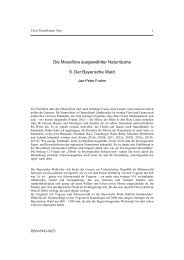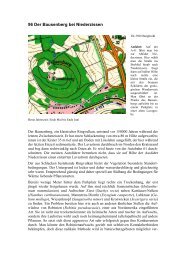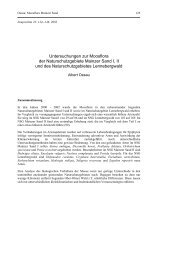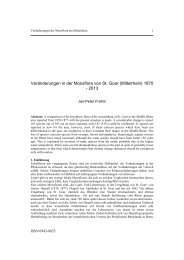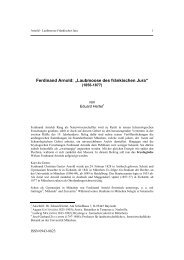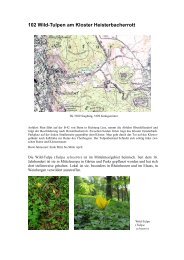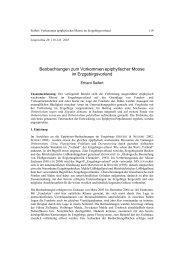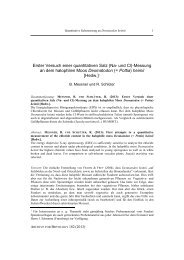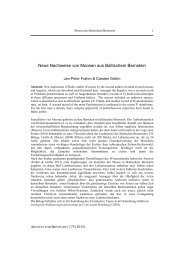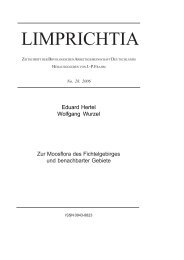Checklist of the bryophytes of Tamil Nadu, India - Jan-Peter Frahm
Checklist of the bryophytes of Tamil Nadu, India - Jan-Peter Frahm
Checklist of the bryophytes of Tamil Nadu, India - Jan-Peter Frahm
Create successful ePaper yourself
Turn your PDF publications into a flip-book with our unique Google optimized e-Paper software.
ARCHIVE FOR BRYOLOGY 65 (2010)<br />
<strong>Checklist</strong> <strong>of</strong> <strong>the</strong> <strong>bryophytes</strong> <strong>of</strong> <strong>Tamil</strong> <strong>Nadu</strong>, <strong>India</strong><br />
<strong>the</strong> East Coast <strong>the</strong>re is a large tract <strong>of</strong> mangrove forests. Unfortunately, <strong>the</strong> forests in <strong>Tamil</strong> <strong>Nadu</strong><br />
are now fragmented, particularly those along <strong>the</strong> hill tracts due to <strong>the</strong> introduction <strong>of</strong> various<br />
plantation crops such as c<strong>of</strong>fee, tea and pine by <strong>the</strong> British as early as <strong>the</strong> beginning <strong>of</strong> <strong>the</strong> 19th<br />
century. Plantations <strong>of</strong> Eucalyptus, Acacia, teak, rubber, Albizia and clove were also introduced by<br />
<strong>the</strong> State Forest Department till <strong>the</strong> late 20th century. On <strong>the</strong> o<strong>the</strong>r hand, private estates have<br />
contributed considerably to <strong>the</strong> destruction <strong>of</strong> <strong>the</strong> rich forests <strong>of</strong> <strong>the</strong> Western Ghats. Added to<br />
<strong>the</strong>se, holiday resorts, educational institutions, factories/industries, etc. have largely contributed to<br />
<strong>the</strong> annihilation <strong>of</strong> <strong>the</strong>se forests in a number <strong>of</strong> areas making <strong>the</strong>m fragmentary. Thus, <strong>the</strong> forests<br />
in <strong>Tamil</strong> <strong>Nadu</strong> have suffered destruction for over a century. This has led to a great loss <strong>of</strong><br />
biodiversity, particularly <strong>the</strong> lower groups <strong>of</strong> organisms, due to loss <strong>of</strong> habitats and an increasing<br />
environmental pollution, and <strong>bryophytes</strong> are no exception. Consequently, <strong>the</strong> majority <strong>of</strong><br />
<strong>bryophytes</strong> have become threatened in <strong>Tamil</strong> <strong>Nadu</strong> (personal observation).<br />
As no Conservation Assessment Management Plan (CAMP) has been done for any group <strong>of</strong><br />
<strong>bryophytes</strong> in <strong>India</strong>, <strong>the</strong> exact status <strong>of</strong> <strong>the</strong>se plants is still not known. Hence, a bryophyte<br />
checklist for <strong>Tamil</strong> <strong>Nadu</strong> can act as baseline information for <strong>the</strong> conservation <strong>of</strong> this group, for<br />
bryologists and o<strong>the</strong>rs interested in <strong>bryophytes</strong>.<br />
History <strong>of</strong> bryophyte recording in <strong>Tamil</strong> <strong>Nadu</strong><br />
The present knowledge on <strong>the</strong> <strong>bryophytes</strong> <strong>of</strong> <strong>Tamil</strong> <strong>Nadu</strong> began with studies by European<br />
bryologists during <strong>the</strong> 19th century. Montagne (1842a) reported 66 species <strong>of</strong> mosses from <strong>the</strong><br />
Nilgiri Hills (<strong>Tamil</strong> <strong>Nadu</strong>) in Cryptogamae Nilgherienses, and Müller (1853) reported 56 species<br />
<strong>of</strong> mosses from <strong>the</strong> Nilgiris in Musci Neilgherrensis. Mitten (1859) reported over 700 species in<br />
his Musci <strong>India</strong>e Orientalis, <strong>of</strong> which 145 were from <strong>Tamil</strong> <strong>Nadu</strong>, and Dixon (1914) reported 35<br />
species from <strong>the</strong> state. From <strong>the</strong> Western Ghats <strong>of</strong> Madurai (<strong>Tamil</strong> <strong>Nadu</strong>), Potier de la Varde<br />
(1922–1924) reported 48 species in his Musci Madurensis, 49 species in Nouvelles herborisations<br />
dans le sud de l’Inde (1925) and 7 species in Musci novi Indici (1928). Dixon and Potier de la<br />
Varde reported 80 species from <strong>India</strong> in <strong>the</strong>ir Contribution à la flore bryologique de l’Inde<br />
meridionale (1927), and 56 species from <strong>Tamil</strong> <strong>Nadu</strong> in Nouvelle contribution à la flore<br />
bryologique de l’Inde (1930). Foreau (1961, 1964) listed 368 species <strong>of</strong> mosses from <strong>the</strong> Palni<br />
hills (W. Ghats <strong>of</strong> Madurai) which included 95 new species and 15 new varieties. Gangulee’s<br />
invaluable Mosses <strong>of</strong> eastern <strong>India</strong> and adjacent regions (1969–1980) provides some information<br />
on <strong>the</strong> habitats and distribution <strong>of</strong> south <strong>India</strong>n mosses and occasionally mentions occurrences in<br />
<strong>Tamil</strong> <strong>Nadu</strong>, though site names and collections data are usually lacking. Wadhwa (1969, 1971)<br />
provided a partial species checklist with references to moss records from peninsula <strong>India</strong>,<br />
including <strong>the</strong> Western Ghats and Nilgiris. More recent works include Mat<strong>the</strong>w (1973) and<br />
Mohamed (1981, 1982, 1984) on Rhodobryum commersonii (Schwägr.) Paris and R. aubertii<br />
(Schwägr.) Thér. in South <strong>India</strong>, on Bryum wightii Mitt. and related species, and a synopsis <strong>of</strong> <strong>the</strong><br />
genus Rhodobryum in Asia respectively. Ochi (1985) published an annotated list <strong>of</strong> mosses <strong>of</strong> <strong>the</strong><br />
subfamily Bryoideae in South, Sou<strong>the</strong>ast and East Asia, Ellis (1989) made a revision on <strong>the</strong> genus<br />
Calymperes in sou<strong>the</strong>rn <strong>India</strong> and neighbouring islands. Lal (2005) published a checklist <strong>of</strong> <strong>India</strong>n<br />
mosses but did not specifically mention reports from <strong>Tamil</strong> <strong>Nadu</strong>, but ra<strong>the</strong>r collectively as 'South<br />
<strong>India</strong>': <strong>the</strong>se records are not cited in this checklist.<br />
Similarly, <strong>the</strong> present knowledge <strong>of</strong> <strong>the</strong> liverworts and hornworts <strong>of</strong> <strong>Tamil</strong> <strong>Nadu</strong> began with<br />
Montagne (1842b), who reported 34 species <strong>of</strong> liverworts from <strong>the</strong> Nilgiri Hills (<strong>Tamil</strong> <strong>Nadu</strong>) in<br />
Cryptogamae Nilgherienses. Subsequently, Mitten (1861) reported 26 species from <strong>Tamil</strong> <strong>Nadu</strong> in<br />
Hepaticae <strong>India</strong>e Orientalis. The works <strong>of</strong> Stephani (1900–1924), Benedix (1953), Chopra (1938),<br />
Udar (1976), Udar and Srivastava (1975, 1977), Asthana and Srivastava (1991), Asthana et al.<br />
(1995), Nath and Asthana (1998), Parihar et al., (1994), Singh (1994, 2002) and Srivastava and<br />
Srivastava (2002), and many o<strong>the</strong>rs, contain records <strong>of</strong> collections from <strong>India</strong>, among which are<br />
records from <strong>Tamil</strong> <strong>Nadu</strong>.<br />
3




